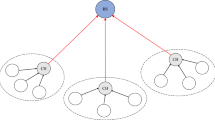Abstract
Unbalanced energy consumption is an inherent problem in gradient sinking sensor networks. This uneven energy dissipation can lead to the existence of energy holes, and significantly reduce network lifetime. In this paper, our study is based on corona-based network division. We investigate the unbalanced energy consumption among nodes both within the same coronas and within different coronas. We take advantage of mixed-routing strategy to achieve balanced energy consumption among nodes both within the same coronas and within different coronas. Besides, once the mixed-routing strategy can not balance energy consumption in local areas, the strategy of nonuniform energy distribution is used in these areas. Finally, we give algorithms to compute the optimal data distribution ratio and the initial energy of nodes. Simulation results show that our strategy can reduce the energy consumption, avoid energy holes and prolong the network lifetime dramatically.
Similar content being viewed by others
References
Akyildiz I. F., Su W., Sankarasubramaniam Y., Cayirci E. (2002) Wireless sensor networks: A survey. Computer Networks 38(4): 393–422
Kahn, J. M., Katz, R. H., & Pister, K. S. (1999). Next century challenges: Mobile networking for smart dust. In Proceedings of ACM MobiCom, Seattle, WA (pp. 271–278).
Han, K.-H., Ko, Y.-B., & Kim, J.-H. (2004). A novel gradient approach for efficient data dissemination in wireless sensor networks In IEEE 60th vehicular technology conference (Vol. 4, pp. 2979–2983).
Li, J., & Mohapatra, P. (2005). An analytical model for the energy hole problem in many-to-one sensor networks. In Proceedings of 62nd IEEE vehicular technology conference (VTC-Fall 05) (pp. 2721–2725).
Li J., Mohapatra P. (2007) Analytical modeling and mitigation techniques for the energy hole problem in sensor networks. Pervasive and Mobile Computing 3: 233–254
Lian J., Naik K., Agnew G. B. (2006) Data capacity improvement of wireless sensor networks using non-uniform sensor distribution. International Journal of Distributed Sensor Networks 2: 121–145
Wu X., Chen G., Das S. K. (2008) Avoiding energy holes in wireless sensor networks with nonuniform node distribution. IEEE Transactions on Parallel and Distributed Systems 19(5): 710–720
Bi Y., Li N., Sun L. (2007) DAR: An energy-balanced data gathering scheme for wireless sensor networks. Computer Communications 30(14–15): 2812–2825
Olariu, S., & Stojmenovic, I. (2006). Design guidelines for maximizing lifetime and avoiding energy holes in sensor networks with uniform distribution and uniform reporting. In Proceedings of IEEE INFOCOM 06 (pp. 1–12), April 2006.
Limin S., Hongsong Z., Bin D., Xiaowei L., Yi S. (2008) Analysis of forwarding mechanisms on fine-grain gradient sinking model in WSN. Journal of Signal Processing Systems 51(2): 145–159
Heinzelman W. B., Chandrakasan A. P., Balakrishnan H. (2002) An application-specific protocol architecture for wireless microsensor networks. IEEE Transactions on Wireless Communications 1: 660–670
Younis O., Fahmy S. (2004) HEED: A hybrid, energy-efficient distributed clustering approach for ad hoc sensor networks. IEEE Transactions on Mobile Computing 3: 366–379
Soro, S., & Heinzelman, W. (2005). Prolonging the lifetime of wireless sensor networks via unequal clustering. In Proceedings of 19th international parallel and distributed processing symposium (IPDPS 05), April 2005.
Li, C., Ye, M., Chen, G., & Wu, J. (2005). EECS: An energy efficient clustering scheme in wireless sensor networks. In Proceedings of 24th IEEE international performance, computing, and communication conference (IPCCC 05) (pp. 535–540).
Li, C., Ye, M., Chen, G., & Wu, J. (2005). An energy-efficient unequal clustering mechanism for wireless sensor networks. In Proceedings of Second IEEE International Conference on Mobile Ad-Hoc and Sensor Systems (MASS 05), November 2005.
Zhang H., Shen H. (2009) Balancing energy consumption to maximize network lifetime in data-gathering sensor networks. IEEE Transactions on Parallel and Distributed Systems 20(10): 1526–1539
Efthymiou C., Nikoletseas S., Rolim J. (2006) Energy balanced data propagation in wireless sensor networks. Wireless networks 12(6): 691–707
Zheng J., Wang P., Li C. (2010) Distributed data aggregation using slepian-wolf coding in cluster-based wireless sensor networks. IEEE Transactions on Vehicular Technology 59(5): 2564–2574
Powell O., Leone P., Rolim J. (2007) Energy optimal data propagation in wireless sensor networks. Journal of Parallel and Distributed Computing 67: 302–317
Jarry, A., Leone, P., Powell, O., & Rolim, J. (2006). An optimal data propagation algorithm for maximizing the lifespan of sensor networks. In Proceedings of distributed computing in sensor systems (DCOSS 06) (pp. 405–421).
Lian, J., Naik, K., & Agnew, G. B. (2005). Modelling and enhancing the data capacity of wireless sensor networks, Chapter 3.5. In T. La Porta & S. Phoha (Eds.), Sensor network operations (pp. 157–179). IEEE Press.
Author information
Authors and Affiliations
Corresponding author
Additional information
This research was supported by the Fundamental Research Funds for the Central Universities of China(12NZYQN18).
Rights and permissions
About this article
Cite this article
Liu, T. Avoiding Energy Holes to Maximize Network Lifetime in Gradient Sinking Sensor Networks. Wireless Pers Commun 70, 581–600 (2013). https://doi.org/10.1007/s11277-012-0709-0
Published:
Issue Date:
DOI: https://doi.org/10.1007/s11277-012-0709-0




